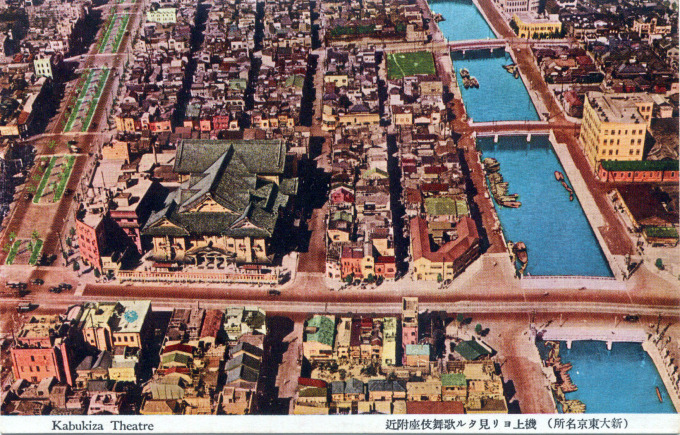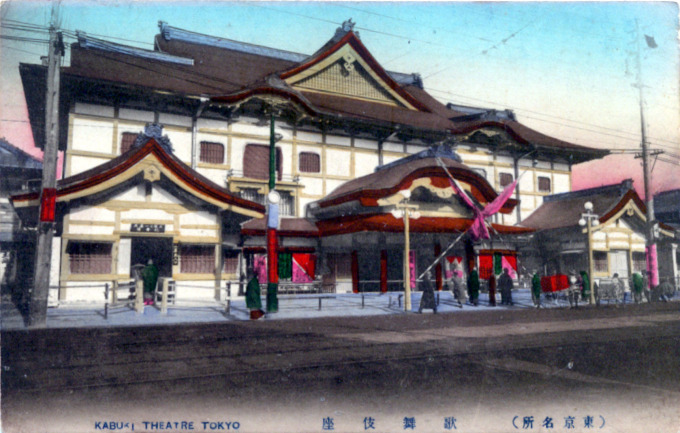
The Kabuki-za, Ginza, Tokyo, c. 1910. For over 130 years, Kabuki-za has been Japan’s premier Kabuki theater. This was the second structure on the site, opened in 1889 and re-imagined in 1911 by architect Kashiwagi Tashichi, and was the largest theater in Japan at the time. This structure would burn down in 1921; its replacement delayed by the 1923 Great Kanto earthquake.
See also:
View of the stage and interior, Kabukiza, Tokyo, c. 1960
Kabuki theater, and Kabuki actors
How Faubion Bowers Saved Kabuki
“Theatre-going in Japan is the luxury of the unemployed. When an entertainment commences at nine o’clock in the morning and lasts all afternoon, the busy man knows that he must only at long and rare intervals allow himself the dissipation of witnessing a theatrical performance, which is often a very fatiguing ordeal to boot … for the performance lasts for ten mortal hours, and hunger and thirst will often assail [the] patron during that long spell of looking and listening.
“… If the play is at all popular the crowd seeking admission is sometimes very large (for there are always many apparently unemployed people even in this busy Metropolis), and you must take your place in the queue and wait patiently for your turn to come.”
– Everyday Japan: Written After Twenty-Five Years Residence and Work in the Country, Arthur Lloyd, 1909
- Kabuki Theatre, Tokyo, c. 1920. This was the second Kabuki theater built on the site. It opened in 1889. An electrical fire resulted in its destruction in 1921.
- Kabukiza, exterior, Tokyo, c. 1930. Completed in 1924, Its reopening was delayed by the 1923 Great Kanto Earthquake.
“Tickets for a Kabuki [lit. ‘song dance skill’] performance are sold for individual acts as well as for each play in its entirety. Because a whole Kabuki program can run from morning to evening and many spectators often attend for only a single play or scene, there is a constant coming-and-going at the theater. At mealtimes food is served to the viewers. The programs incorporate themes and customs that reflect the four seasons or insert material derived from contemporary events.
“After being banished in the 17th century to the hinterland by prudish Tokugawa rulers, Kabuki made its formal return to the capital city in the late 19th century with the establishment of the Kabuki-za [theater] in 1889 in the Kobikicho neighborhood of Tokyo’s Ginza district. There have been three theaters built on this location.
“The first Kabuki-za was originally the daimyo [provincial lord] residence of the Matsudaira clan of Izu. In 1889, a true theater, the second Kabuki-za, was built – the largest theater at that time in Japan – with a stage nearly 80-feet wide and with a 54-foot revolving stage. An electrical fire burned down this theater in 1921.
“A new Kabuki-za, the third, was being built on the site – this time in a Baroque-Japanese revivalist style (i.e., Wafu-Momoyama), meant to evoke the architectural details of Japanese castles, as well as temples of pre-Edo period. This theater, still under construction, was severely damaged by the 1923 Great Kanto earthquake. However, it was quickly repaired and was opened to the public in 1924.”
– Wikipedia

Kabuki-za, exterior, Tokyo, c. 1930. The third structure built on the site, this fusion of Baroque-Momoyama architecture was meant to invokea the idea of Japanese castles and pre-Edo period temples. It opened in 1924 after its predecessor burned down in 1921.

Kabuki-za, sidewalk view, Tokyo, c. 1960. Destroyed by wartime firebombing in May 1945, the theater was rebuilt to its prewar appearance and reopened in 1951.
“One particularly haunting reminder of the wrath visited upon the city by American bombers in 1945 had remained in place throughout most of [the Occupation] period, its soiled white outer walls a shroud, its large, glassless windows ghostly, soot-smeared eyes, its shattered inner recesses skeletal and open to the sky.
“This was Japan’s foremost playhouse, the grandiose Kabuki-za, located near the city’s bustling Ginza district, and once the proud bastion of the spectacular, musical, dramatic, totally theatrical genre called kabuki. When it was finally renovated and reopened, in January 1951, its rebirth was greeted as a symbol of phoenix-like regeneration for Japanese culture in general, and – its fame spread worldwide by Japan’s increasing postwar internationalization – it took place as one of the nation’s essential attractions, for foreigners as well as native theatergoers.”
– Kabuki at the Crossroads: Years of Crisis, 1952-1965, by Samuel L. Leiter, 2013

Kabuki-za, aerial view, Tokyo, c. 1940, showing its size relative to its Ginza neighborhood surroundings. The tree-lined avenue to its left is Showa-dori, a boulevard that was purposed to serve as a fire-break in the aftermath of the 1921 Great Kanto Earthquake.
[Note: In April 2010, the Kabukiza was closed for a complete renovation. Plans included the incorporation of its wafu [Japanese-style fusion] facade onto a more modern 29-story high-rise Kabukiza Tower. The “new” Kabuki-za reopened in 2013.]




Pingback: Tokyo Gekijo (Theater), Tsukiji, c. 1930. | Old Tokyo
Pingback: Shimbashi District. | Old Tokyo
Pingback: View of the stage and interior, Kabukiza, Tokyo, c. 1960. | Old Tokyo
Pingback: How Faubion Bowers Saved Kabuki. | Old Tokyo
Pingback: Shintomi-za Theatre, Tokyo, c. 1920. | Old Tokyo
Pingback: Kabuki theater & Kabuki actors, c. 1910. | Old Tokyo
Pingback: Shintomi-za Theatre, Tokyo, c. 1920. | Old TokyoOld Tokyo